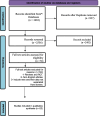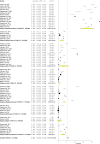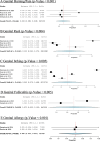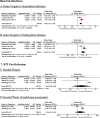Effects of pubic hair grooming on women's sexual health: a systematic review and meta-analysis
- PMID: 38468306
- PMCID: PMC10926629
- DOI: 10.1186/s12905-024-02951-1
Effects of pubic hair grooming on women's sexual health: a systematic review and meta-analysis
Abstract
Background: Pubic hair grooming involves the partial or complete removal of pubic hair, and it is a common practice among men and women. Grooming is more prevalent in women, who employ various methods such as shaving, waxing and laser removal. However, it is associated with variable rates of post-grooming adverse outcomes including lacerations and sexually transmitted infections (STIs). To the best of our knowledge, this is the first systematic review and meta-analysis comparing women's sexual health outcomes between those who groom and those who don't.
Methods: We followed the MOOSE guidelines and conducted a computerized-based search using (PubMed, Web of Science, Scopus, and Ovid Medline), till June 20th, 2022, for eligible studies using the relevant keywords; (pubic hair grooming) OR (pubic hair removal OR Genital hairless OR Bikini hair removal OR pubic hair depilation). Cross-sectional studies included which compared grooming practices among women in terms of motivation and health outcomes. Women's satisfaction and incidence of STIs were pooled as standardized mean difference (SMD) and odds ratio (OR) respectively.
Results: Twenty-Two cross-sectional studies were included in our review with 73,091 participant.The odds of having gram-negative gonorrheal and chlamydial infection in Pubic hair groomers were found to be statistically significant (OR = 1.55, 95% CI [1.31, 1.84], P < 0.001) (OR = 1.56, 95% CI [1.32, 1.85], P < 0.001] respectively. There was no difference between groomer and non-groomer women regarding viral infections such as genital herpes (OR = 1.40, 95% CI [0.56, 3.50], P = 0.47) and Condyloma acuminata (OR = 1.75, 95% CI [0.51, 6.01], P = 0.37). The most common grooming side effect is genital itching (prevalence = 26.9%, P < 0.001). Non-electrical razor (prevalence = 69.3%, P < 0.001) is the most common grooming method. White women (prevalence = 80.2%, P < 0.001) remove pubic hair more frequently compared to black women (prevalence = 12.2%, P < 0.001). Women practice complete grooming (50.3%, P < 0.001) of the pubic hair more frequently than partial grooming (33.1%, P < 0.001). There are no differences in women's satisfaction between the two groups (SMD = 0.12, 95% CI [-0.16, 0.40], P = 0.39).
Conclusion: This review aligns with previous observational studies regarding sexual health outcomes of pubic hair grooming. There is a need to raise awareness among women regarding the safe practice of pubic hair grooming, emphasizing the clarification of hazards and benefits.
Keywords: Grooming; Meta-analysis; Pubic Hair; STI; Women's Health.
© 2024. The Author(s).
Conflict of interest statement
The authors declare no competing interests.
Figures







Similar articles
-
Correlation between pubic hair grooming and STIs: results from a nationally representative probability sample.Sex Transm Infect. 2017 May;93(3):162-166. doi: 10.1136/sextrans-2016-052687. Epub 2016 Dec 5. Sex Transm Infect. 2017. PMID: 27920223
-
Pubic Hair Grooming and Sexually Transmitted Infections: A Clinic-Based Cross-Sectional Survey.Sex Transm Dis. 2020 Jun;47(6):419-425. doi: 10.1097/OLQ.0000000000001176. Sex Transm Dis. 2020. PMID: 32187167
-
Pubic hair grooming practices in KwaZulu-Natal, South Africa: prevalence, side effects and association with sexually transmitted infections.Int J STD AIDS. 2020 Oct;31(11):1034-1039. doi: 10.1177/0956462420941709. Epub 2020 Aug 4. Int J STD AIDS. 2020. PMID: 32753000
-
Effect of preoperative hair removal vs. no removal on surgical site infections: a systematic review and meta-analysis.F1000Res. 2024 Dec 5;13:1487. doi: 10.12688/f1000research.158369.1. eCollection 2024. F1000Res. 2024. PMID: 39810848 Free PMC article.
-
Epilation and depilation in the genital area - motivation, methods, risks and recommendations from a dermatological point of view.J Dtsch Dermatol Ges. 2023 May;21(5):455-462. doi: 10.1111/ddg.14993. Epub 2023 Mar 24. J Dtsch Dermatol Ges. 2023. PMID: 36960835 Review.
Cited by
-
Pubic hair removal practices among women: Findings from a U.S. nationally representative survey.Womens Health (Lond). 2024 Jan-Dec;20:17455057241296982. doi: 10.1177/17455057241296982. Womens Health (Lond). 2024. PMID: 39534947 Free PMC article.
-
Pubic Hair Removal Practices and Motivations Among a Nationally Representative Sample of U.S. Men.Am J Mens Health. 2024 Sep-Oct;18(5):15579883241279830. doi: 10.1177/15579883241279830. Am J Mens Health. 2024. PMID: 39340386 Free PMC article.
References
Publication types
MeSH terms
LinkOut - more resources
Full Text Sources
Medical

